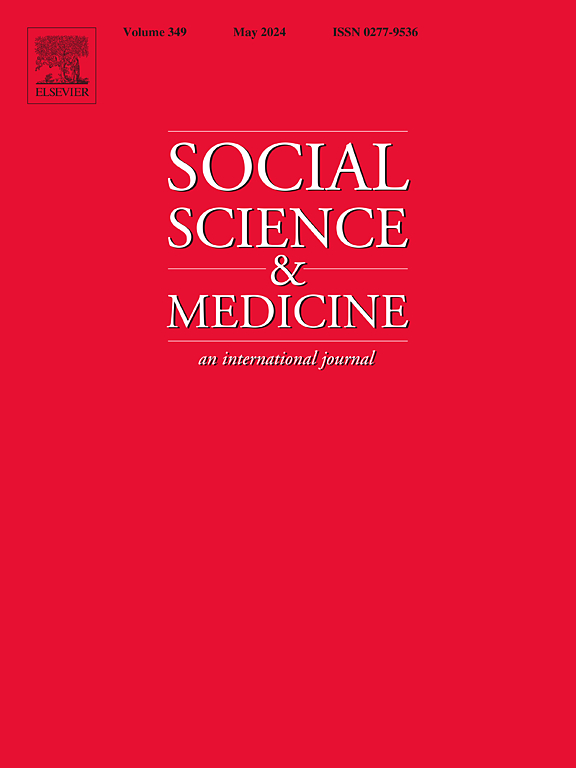晚年主观和客观健康之间的差异会随着时间的推移而改变吗?马尔可夫转换模型
IF 4.9
2区 医学
Q1 PUBLIC, ENVIRONMENTAL & OCCUPATIONAL HEALTH
引用次数: 0
摘要
老年人主观健康(SH)的恶化速度低于客观健康(OH)。然而,关于同一人的主观健康状况和客观健康状况之间的差异是否会随着时间的推移而发生变化的证据却很少。我们通过前瞻性、观察性队列研究设计,对居住在英格兰的老年人样本进行了调查,以了解这种差异是否会随着时间的推移而发生变化。利用英国老龄化纵向研究的数据,我们对基线年龄在 60 岁以上的 6803 名老年人样本进行了三波数据收集(2002-2007 年),产生了两波过渡。健康不对称 "指标根据老年人的 "健康悲观主义者 "和 "健康乐观主义者 "得分之间的一致程度,在每个波次将老年人分为四类("健康悲观主义者"、"健康乐观主义者"、"健康现实主义者 "和 "健康现实主义者")。一阶马尔可夫转换模型和广义对数模型估算出了健康不对称随时间变化的转换概率和几率比率。基线样本中有 36.84% 是 "良好健康现实主义者",33% 是 "不良健康现实主义者",14.54% 是 "健康乐观主义者",15.62% 是 "健康悲观主义者"。健康状况良好和健康状况较差的现实主义者可能会长期保持健康状况现实。然而,健康状况良好的现实主义者很可能会转变为健康状况乐观主义者。随后,健康乐观主义者在样本中的比例随着时间的推移而增加。健康悲观主义者很有可能因研究减员而流失。总之,随着时间的推移,健康乐观主义(即 "健康乐观 "比 "健康悲观 "更好)在晚年生活中越来越普遍。未来的研究应探讨在健康悲观主义者和健康现实主义者中推广积极的健康乐观主义评价是否能优化健康和生存结果。本文章由计算机程序翻译,如有差异,请以英文原文为准。
Do discrepancies between subjective and objective health shift over time in later life? A markov transition model
Subjective health (SH) deteriorates less rapidly than objective health (OH) in older adults. However, scant evidence exists regarding if discrepancies between SH and OH shift in the same individuals over time. We explore whether such discrepancies change over time in a sample of older adults living in England, through a prospective, observational cohort study design. Using data from the English Longitudinal Study of Ageing, we followed a sample of 6803 older adults, aged 60+ years at baseline, over three waves of data collection (2002–2007), yielding two wave transitions. A ‘health asymmetry’ metric classified older adults into four categories at each wave, based on the level of agreement between their SH and OH scores (‘health pessimist’, ‘health optimist’, ‘good health realist’ and ‘poor health realist’). First-order Markov transition and generalised logit models yielded estimated transition probabilities and odds ratios for health asymmetry transitions over time. At baseline, 36.84% of the sample were ‘good health realists’, 33% were ‘poor health realists’, 14.54% were ‘health optimists’, and 15.62% were ‘health pessimists’. Good and poor health realists were likely to remain health realistic over time. Good health realists who did transition however, were likely to become health optimists. Subsequently, the proportion of health optimists in the sample increased over time. Health pessimists had a high probability of being lost to study attrition. In conclusion, health optimism (i.e. where SH is rated better than OH) becomes more prevalent over time, in later life. Future research should investigate if promoting positive SH appraisals among health pessimists and poor health realists can optimise health and survival outcomes.
求助全文
通过发布文献求助,成功后即可免费获取论文全文。
去求助
来源期刊

Social Science & Medicine
PUBLIC, ENVIRONMENTAL & OCCUPATIONAL HEALTH-
CiteScore
9.10
自引率
5.60%
发文量
762
审稿时长
38 days
期刊介绍:
Social Science & Medicine provides an international and interdisciplinary forum for the dissemination of social science research on health. We publish original research articles (both empirical and theoretical), reviews, position papers and commentaries on health issues, to inform current research, policy and practice in all areas of common interest to social scientists, health practitioners, and policy makers. The journal publishes material relevant to any aspect of health from a wide range of social science disciplines (anthropology, economics, epidemiology, geography, policy, psychology, and sociology), and material relevant to the social sciences from any of the professions concerned with physical and mental health, health care, clinical practice, and health policy and organization. We encourage material which is of general interest to an international readership.
 求助内容:
求助内容: 应助结果提醒方式:
应助结果提醒方式:


